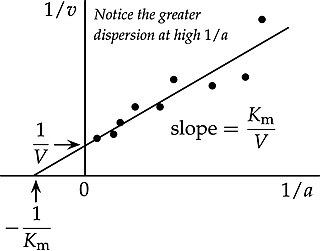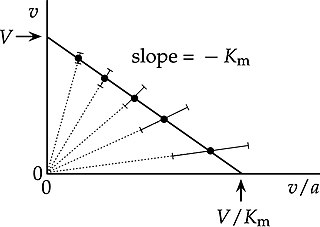
In biochemistry, Michaelis–Menten kinetics, named after Leonor Michaelis and Maud Menten, is the simplest case of enzyme kinetics, applied to enzyme-catalysed reactions of one substrate and one product. It takes the form of a differential equation describing the reaction rate to , the concentration of the substrate A. Its formula is given by the Michaelis–Menten equation:

Georg Michaelis was the chancellor of the German Empire for a few months in 1917. He was the first chancellor not of noble birth to hold the office. With an economic background in business, Michaelis' main achievement was to encourage the ruling classes to open peace talks with Russia. Contemplating that the end of the war was near, he encouraged infrastructure development to facilitate recovery at war's end through the media of Mitteleuropa. A somewhat humourless character, known for process engineering, Michaelis was faced with insurmountable problems of logistics and supply in his brief period as chancellor.

In biochemistry, the Lineweaver–Burk plot is a graphical representation of the Michaelis–Menten equation of enzyme kinetics, described by Hans Lineweaver and Dean Burk in 1934.

In biochemistry, an Eadie–Hofstee plot is a graphical representation of the Michaelis–Menten equation in enzyme kinetics. It has been known by various different names, including Eadie plot, Hofstee plot and Augustinsson plot. Attribution to Woolf is often omitted, because although Haldane and Stern credited Woolf with the underlying equation, it was just one of the three linear transformations of the Michaelis–Menten equation that they initially introduced. However, Haldane indicated latter that Woolf had indeed found the three linear forms:
In 1932, Dr. Kurt Stern published a German translation of my book Enzymes, with numerous additions to the English text. On pp. 119–120, I described some graphical methods, stating that they were due to my friend Dr. Barnett Woolf. [...] Woolf pointed out that linear graphs are obtained when is plotted against , against , or against , the first plot being most convenient unless inhibition is being studied.
Non-competitive inhibition is a type of enzyme inhibition where the inhibitor reduces the activity of the enzyme and binds equally well to the enzyme whether or not it has already bound the substrate. This is unlike competitive inhibition, where binding affinity for the substrate in the enzyme is decreased in the presence of an inhibitor.

Enzyme kinetics is the study of the rates of enzyme-catalysed chemical reactions. In enzyme kinetics, the reaction rate is measured and the effects of varying the conditions of the reaction are investigated. Studying an enzyme's kinetics in this way can reveal the catalytic mechanism of this enzyme, its role in metabolism, how its activity is controlled, and how a drug or a modifier might affect the rate.

The Indonesian speckled carpetshark, Hemiscyllium freycineti, is a species of bamboo shark in the family Hemiscylliidae. It is found in the shallow ocean around the Raja Ampat Islands in West Papua, Indonesia, but was formerly believed to be more widespread. This was due to confusion with H. michaeli, a species described from eastern Papua New Guinea in 2010. Compared to that species, the spots on H. freycineti are smaller, more rounded or slightly elongated in shape, and tend to darken at regular intervals forming 8-9 vertical bars on the body and tail. Furthermore, the large black spot behind the pectoral fin is more clearly defined in H. michaeli than in H. freycineti. Confusingly, some books with illustrations and photos labelled as H. freycineti actually show H. michaeli.

Sir Maximillian Michaelis, was a South African financier, mining magnate, benefactor and patron of the arts.

In biochemistry, a Hanes–Woolf plot, Hanes plot, or plot of against is a graphical representation of enzyme kinetics in which the ratio of the initial substrate concentration to the reaction velocity is plotted against . It is based on the rearrangement of the Michaelis–Menten equation shown below:

Merav Michaeli is an Israeli politician, journalist, TV anchor, radio broadcaster, feminist, and activist currently serving as a member of the Knesset for the Democrats, which was formed in 2024 by a merger of the Labor and Meretz. She served as the Labor Party's leader from 2021 until 2024, and as Minister of Transport in the thirty-sixth government of Israel.

Polyrhaphis is a genus of longhorn beetles of the subfamily Lamiinae, containing the following species:
Polyrhaphis belti is a species of beetle in the family Cerambycidae. It was described by Hovore and McCarty in 1998. It is known from Honduras, Costa Rica, Guatemala, Ecuador, Nicaragua, Colombia, and Panama.

Polyrhaphis fabricii is a species of beetle in the family Cerambycidae. It was described by James Thomson in 1865. It is known from Ecuador, Brazil, Peru, French Guiana, Suriname, and Guyana.

Polyrhaphis jansoni is a species of beetle in the family Cerambycidae. It was described by Francis Polkinghorne Pascoe in 1859. It is known from Ecuador and Brazil.
Polyrhaphis lanei is a species of beetle in the family Cerambycidae. It was described by Santos-Silva, Martins and Tavakilian in 2010.

Polyrhaphis papulosa is a species of beetle in the family Cerambycidae. It was described by Guillaume-Antoine Olivier in 1795. It is known from Colombia, Peru, Brazil, and French Guiana.

Polyrhaphis peruana is a species of beetle in the family Cerambycidae. It was described by Santos-Silva, Martins and Tavakilian in 2010.
Polyrhaphis spinipennis is a species of beetle in the family Cerambycidae. It was described by Laporte in 1840. It is known from South America.
Polyrhaphis turnbowi is a species of beetle in the family Cerambycidae. It was described by Hovore and McCarty in 1998. It is known to be found in Panama.

The Montebello Design Centre is a non-profit art and craft space established in 1993 and located in Newlands, Cape Town, South Africa. The centre hosts over twenty craft workshops, shops, restaurants, and artist studios.













